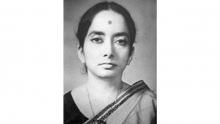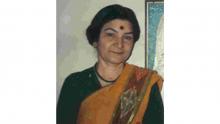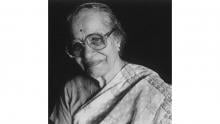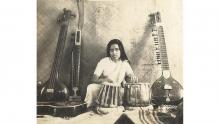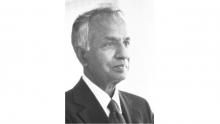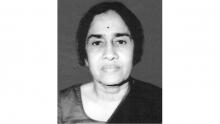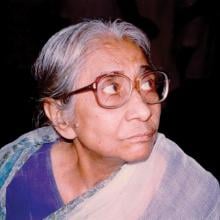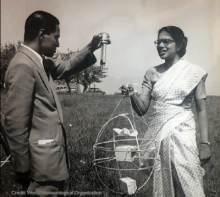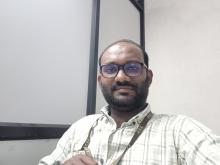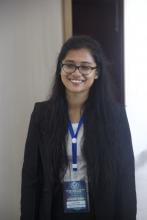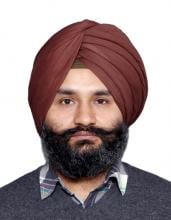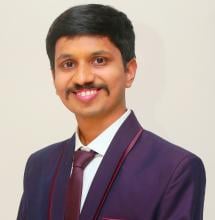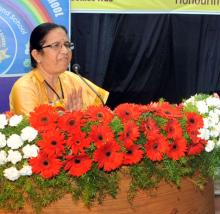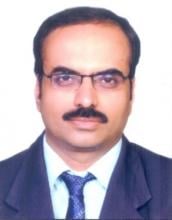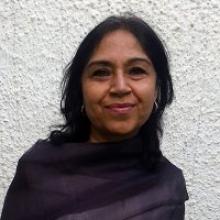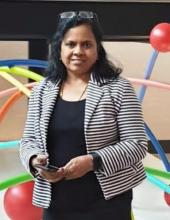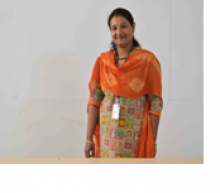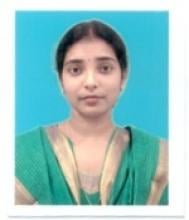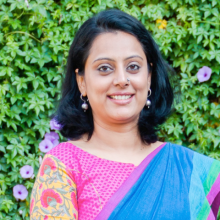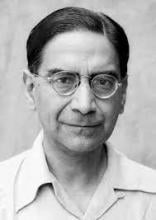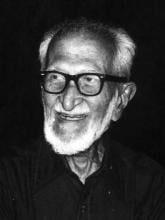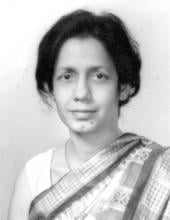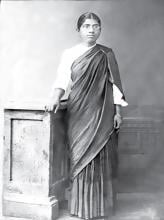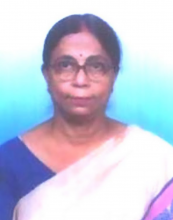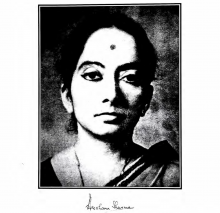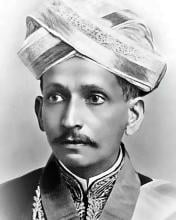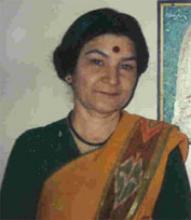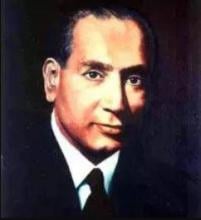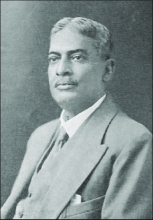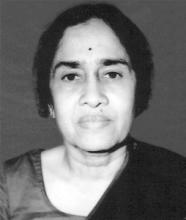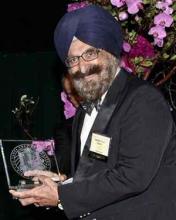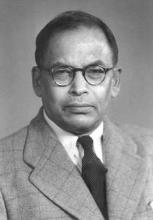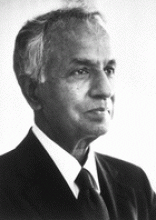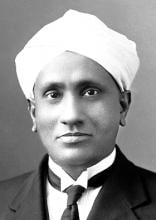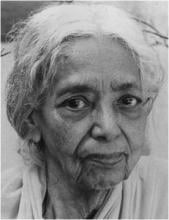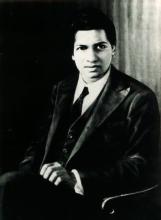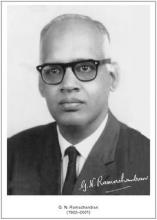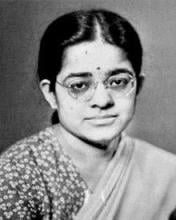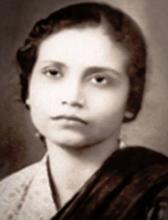India
News
15 Apr 2024
Once a two-armed attendant to the goddess Tara, over time, Marichi was increasingly endowed with power until she became a deity in her own right. Revered as a warrior and guardian against evil and darkness, Marichi’s imagery reveals myriad symbolisms — from her association with the sun to her role as a fierce protector. Read about the multifaceted nature of Marichi's mythology and imagery, spanning nations, cultures, and time.
01 Apr 2024
In India’s dry, western-most state — Rajasthan — the gods are carried from village to village, and tales that surround the deity are narrated so that the devout may be blessed. The gods are housed in a ‘kavad’, a portable shrine adorned with intricate narrative paintings of folk tales and epics. Constructed from low-density wood and painted with mineral-derived pigments, the kavad serves as a conduit for the oral storytelling tradition known as kavad banchana. Learn about the synergy between the makers, painters and patrons of these shrines, and how this tradition continues to evolve.
19 Mar 2024
In the late 1930s, French archaeologists discovered a large and remarkable group of ivory sculptures, in Afghanistan's Begram (present-day Bagram). Stipulated to have been used as accents or embellishments for wooden furniture, these carved objects showcase a blend of Greco-Roman, Central Asian, Mediterranean, and Indic stylistic influences. Despite the political upheavals in the region, some of these ivory artefacts still survive. Explore how ongoing scholarly efforts shed light on the historical significance of these art objects, highlighting the cultural connections that were built and flourished along the Silk Road.
04 Mar 2024
In the early seventeenth century, the royal ateliers of the Mewar kingdom, in present-day western India, witnessed the emergence of a new miniature painting tradition. The Mewar School, as it is known, was patronised by the ruling Sisodia dynasty. Stemming from manuscript illustration, this tradition evolved to encompass intricately detailed portraiture. Delve into the evolution of the Mewar School, tracing its distinct styles, aesthetic influences, master artists, and the shifting preferences of its royal patrons.
19 Feb 2024
Dated to the fourteenth century, the Chandayana is a Sufi romance that narrates the story of the lovelorn protagonists — Chanda and Laurik — in rhyming couplets. It was composed in the Awadhi dialect of Hindi, by the Chishti poet Mulla Daud. Five illustrated manuscripts of the poem were created between the fifteenth and sixteenth centuries, and they are housed in five different locations worldwide. These illustrated texts provide a lens into the history of manuscript paintings in the Indian subcontinent.
29 Jan 2024
Nestled in northern Karnataka, the Badami cave temples of India are adorned with a unique blend of intricate carvings that draw religious motifs from Shaivite, Vaishnavite and Jain traditions. Learn more about these 2nd-century rock-cut shrines that bear testament to ancient Indian royal patronage and religious syncretism.
15 Jan 2024
The Punjab regions of India and Pakistan bear witness to a centuries-old, laborious tradition of embroidering cloth with silk threads. Called Vari da Bagh and Bagh, meaning “‘garden”’, these textiles are ritually significant and are adorned with geometric patterns or motifs that draw from the everyday life and culture of the region.
01 Jan 2024
In the 16th and 17th centuries, religious ivory statuettes sculpted in colonial Goa sported a unique amalgamation of European and ancient Indian symbolisms. Discover the history of this Indo-Portuguese iconography and its ties to local evangelism, slavery and colonial export.
18 Dec 2023
Amongst the earliest objects unearthed from Gandhara are carved stone dishes depicting guardian spirits, mythical creatures and scenes of merrymaking. Despite the carvings being rich in artistic and cultural information, they reveal little about the functions of these objects. Learn more about these enigmatic artefacts, and the material history of ancient Gandhara.
04 Dec 2023
Since nearly the twelfth century, painters, called ‘patuas’, lived around the Jagannatha Temple at Puri in Odisha, painting tales from Hindu and Islamic religious mythologies, and local legends onto cloth scrolls. Discover how the rituals and festivals of the temple, and its principal deities — Jagannatha, Balabhadra, and Subhadra — inspire these paintings.
20 Nov 2023
Created by western India’s nomadic Vaghri community, mata ni pachedi is a tradition of cloth painting dating back 300 years. Originally meant as canopies for shrines and as objects of ritual worship, these textiles depict a pantheon of local goddesses surrounded by regional motifs. Read on to understand how printing, painting and cloth come together in religious consumerism.
06 Nov 2023
Since the 3rd century CE, master puppeteers of southern India have brought the epics of the subcontinent to life through Tholu Bommalata, a form of shadow puppetry performed with elaborate, life-sized leather puppets. Come discover this intricate musical theatre tradition that has been passed down from generation to generation and continues to thrive to this day.
20 Oct 2023
The Cholamandal Artists' Village was established in 1966 to encourage self-sufficiency, community living and the creation of a South Indian visual identity. Since then, it has undergone a transformative journey. Discover its history and achievements.
24 Sep 2023
Amidst the political tumult of nineteenth-century colonial India, Abanindranath Tagore — an artist from Bengal — set out to invent a new ‘Indian’ visual language, rejecting European artistic ideals. He pioneered a style that combined themes from mythology, history, and rural life, with elements from India’s miniature painting traditions. This would evolve into the Bengal School — a movement that reimagined a distinctly Indian approach to art. Tagore influenced an entire generation of artists and left a lasting impact on the quest for Indian identity during the struggle for Independence.
11 Sep 2023
In the mid-sixteenth century, Mughal emperor Humayun brought two Persian master painters to India, who not only established an imperial atelier but also began a major tradition of miniature painting in South Asia — Mughal manuscript paintings. This painting tradition flourished for centuries, enjoying royal patronage and resulted in the illustration of significant literary texts, scriptures, biographies, dynastic histories and scientific literature. Known for their naturalism and intricacy, Mughal paintings also combined a range of influences — Persian, Indian and European — and were often made collaboratively by artists and other specialists in the imperial ateliers, known as kitabkhanas. Discover the legacy and lasting influence of this painting tradition and its eventual decline in the late eighteenth century.
28 Aug 2023
Traditionally woven in Gujarat, India, mashru — meaning ‘lawful’ or ‘permitted’ in Arabic — was invented to allow Muslims to wear silk garments despite injunctions against it in the Hadith, an important Islamic religious text offering teachings and moral guidance. The fabric’s innovative weaving technique, where each silk warp crosses six cotton wefts, keeps silk from touching the body when worn. Whilst the earliest visual references to mashru date back to the seventeenth-century in the Deccan region of southern India, the fabric has lived many lives, gaining popularity amongst Islamic populations in India, West Asia and Africa as it was traded along Indian Ocean maritime routes.
14 Aug 2023
In the early seventeenth century, a new painting tradition — characterised by its use of bold colours, gilding and gem-setting — emerged in the Thanjavur region of southern India. While Thanjavur paintings originally featured gods and saints, the tradition grew to incorporate secular subjects owing to a range of influences over the next several centuries, including Mughal, Maratha, and European art. Thanjavur paintings continue to be popular as memorabilia and worship objects, and are one the most recognisable South Indian painting styles today.
10 Nov 2022
Giants in History: Indian scientist and physician Upendranath Brahmachari (19 December 1873–6 February 1946) is best known for creating a drug called Urea Stibamine, used to safely and reliably treat visceral leishmaniasis (or Kala-azar), a severe infection caused by the Leishmania parasite.
20 Oct 2022
Giants in History: Maharani Chakravorty (1937 – 2015) was one of India’s earliest molecular biologists whose research paved the way for advances in the treatment of bacterial and viral infections.
06 Oct 2022
Giants in History: Archana Sharma (16 February 1932 - 14 January 2008) conducted research into plant and human genetics that expanded the understanding of both botany and human health.
14 Sep 2022
Giants in History: Sir Mokshagundam Srinivasa Shastry Vishveshwarayya (15 September 1860 – 14 April 1962) is widely regarded as India’s most outstanding engineer.
02 Jun 2022
Giants in History: Known for her pioneering contributions to bio-organic chemistry, Darshan Ranganathan (4 June 1941 – 4 June 2001) is considered India’s most prolific chemist.
05 May 2022
Giants in History: Ground-breaking cancer researcher Kamal Jayasing Ranadive (8 November 1917 – 11 April 2001) advanced the understanding of the causes of leukaemia, breast cancer and oesophageal cancer through the use of animal models.
07 Apr 2022
Giants in History: Purnima Sinha (12 October 1927 – 11 July 2015), the first Bengali woman to receive a doctorate in physics, analysed clay structures using x-ray equipment that she built from salvaged World War II-era parts.
30 Mar 2022
Giants in History: Subrahmanyan Chandrasekhar (19 October 1910 – 21 August 1995) was an Indian astrophysicist who studied the structure and evolution of stars.
03 Mar 2022
Giants in History: Gopalasamudram Narayanan Ramachandran (8 October 1922 – 7 April 2001) is best known for developing the Ramachandran plot to understand the structure of short chains of amino acids, known as peptides.
26 Jan 2022
Giants in History: In 1939, biochemist Kamala Sohonie (18 June 1911 – 28 June 1998) became the first woman to be accepted into the Indian Institute of Science (IISc).
15 Nov 2021
Giants in History: Indian organic chemist Asima Chatterjee (1917 to 2006) studied the medicinal properties of plant products, especially compounds known as vinca alkaloids.
15 Sep 2021
Anna Mani (23 August 1918 – 16 August 2001) was an Indian meteorologist who contributed significantly to the understanding of solar radiation, ozone and wind energy by developing a wide range of measurement tools. One of India’s pioneering female scientists, Mani excelled in the male-dominated area of meteorology and became the Deputy Director-General of the India Meteorological Department.
12 Jun 2020
COVID19 is teaching us several new lessons and also preaching us to learn from the past experiences.
Events
26 Nov 2021
Introducing EDUtech India, a virtual festival taking place on 26-27 November to bring together the education community across India.
24 Nov 2011
Academicians, researchers, scientists, policy makers and implementers, and government officials working in the field of nanoscience and nanotechnology in the developing/developed countries, are invited to participate in this international workshop.

12 Oct 2011
This conference educates the engineering and scientific community on the need for lightning protection and safety, proper ways of lightning protection and maintenance and the current international issues and trends with regard to lightning protection, safety and Electromagnetic Compatibility (EMC)

09 Aug 2011
4-days International Conference on the Potentials of New and Advanced materials for Developing Economies in Abuja, Nigeria
06 Dec 2011
The much awaited environment and wildlife biennial international competitive film festival and forum, CMS VATAVARAN is back. Film entries are invited from Indian and International filmmakers for 2011 festival focusing on biodiversity conservation.

11 Oct 2010
The Centre for Science & Technology of the Non-Aligned and Other Developing Countries (NAM S&T Centre) jointly with the National Science Centre and (MOSTI), announces a 4-day International Workshop on Science Centre in Promoting a Knowledge and Innovative Society for Sustained and Responsible Growth in Developing Countries.

02 Aug 2010
In order to discuss the current status, opportunities and trends of industrialisation and employment generation in villages, and creation, innovation and management of micro-enterprises in rural areas through the application of science and technology, the NAM S&T Centre announces the organisation of an International Workshop.

29 Sep 2009
The workshop is aimed at facilitating the sharing of information on various aspects of land degradation, exchanging the country specific information about land degradation, land use decisions and environment, seeking possibilities for cross country projects among NAM members and promoting scientist-to-scientist contact and interactions.

17 Nov 2009
Municipal water supply in most cities is unreliable and many villages in the developing countries do not have potable water supply. In this regard Rainwater Harvesting (RWH) seems an ideal sustainable solution.

18 May 2009
This international workshop aims at bringing together different researchers and academicians in the developing countries in the fields of nanotechnology and nanoscience.

10 Mar 2009
NAM S&T Centre jointly with the Uganda National Academy of Sciences (UNAS) is this roundtable. The current meet is a point in the direction whereby an efficient use of existing resources along with their sustainability is interwoven along with critical aspects relating to biodiversity.

14 Dec 2008
To become leaders in science and technology, the developing countries need to draw upon the talents from all sections of society, including the women with special interest and aptitude in science.

24 Jun 2008
Cleaner production involves persistent approach to prevent pollution, reduce the use of energy, water and material resources and minimize waste in the production process. This workshop will bring together experts to discuss diverse environmental strategies to increase eco-efficiency and minimize energy consumption.

24 Jun 2008
This workshop will be instrumental in bringing together the experts to discuss diverse environmental strategies targeted to cause increase in eco-efficiency and minimizing energy consumption in their respective regions / sub-regions.

16 Apr 2008
Land degradation affects more than 1900 million hectares of land word-wide, including 65% of the
region’s agricultural land. This international event will bring together experts from different fields to facilitate sharing of information on various aspects of land degradation.

25 Feb 2008
It is envisaged that this scientific programme will serve as a platform for experts, policy makers and other Government officials to share experiences and chart appropriate course to promote the science centres as the agents of change in the developing world.

20 Sep 2007
Hanoi, Vietnam - Experts and scientists interested in participating in the Workshop are required to submit their nomination form by 14th August 2007. The selection of the participants will be strictly based on merit and quality of the extended abstracts of the presentation material to be submitted along with the completed Nomination Form.

22 May 2007
Lightning causes serious losses, injuries and deaths. In South and East Asia, Africa and South America the problem is even more severe due to the high occurrence density of lighting, the large population and the rapid and unplanned industrialization. Lack of information and awareness are barriers hindering the development of protection systems.

09 Apr 2007
The objectives of this course are to ‘Exchange country information on Micro and Nano electronics and Photonics, Acquaint participants on the current and next generation devices and Deliberate on North-South and South-South collaboration to develop this sector in the developing countries.

08 Jan 2007
Natural disasters, almost in every case, do offer a new, live laboratory to test our ideas on the whole range of issues from policy formulation to people’s participation. The Roundtable would provide an opportunity to the participants to discuss these issues through case studies, simulated exercises and exchange of information

08 Nov 2006
The conference is aimed at broadly addressing the present S&T policies being followed in various countries with the degree of success and also exploring the possibility of coordination among developing countries on S&T policies.

01 Jul 2006
The seminar aims at highlighting the strategic initiatives taken by IndianJournals.com in the field of e-publishing & promotion of Indian Publications

12 Apr 2006
The seminar aims at highlighting the strategic initiatives taken by IndianJournals.com in the field of e-publishing and promotion of Indian Publications, in order to provide a global exposure along with national recognition, in the larger interest of Academicians, Societies & Publishers.

14 Mar 2006
Incoroprating Seminar on 'Transgenic Plants: A Challenge to Natural Farming and Nature Survival' on March 14, 2006.

06 Sep 2005
this conference will bring together international speakers and delegates to discuss the latest developments in nanotechnology for healthcare

03 Jan 2006
93rd Indian Science Congress on "Integrated Rural Development:Science and Technology" from 3-7 January, Hyderabad, India
Researchers
Dr. Irshad CV completed PhD in Economics (Specialisation: Health Economics) from the Department of Humanities and Social Sciences at the Indian Institute of Technology Madras. He completed a bachelor's and master's in Economics from the University of Calicut. His Ph.D. thesis titled “Healthy Ageing in India: A Mixed Methods Approach” explored various research questions on healthy ageing in India using both quantitative and qualitative tools. His thesis work proposed the first multi- dimensional Healthy Ageing Index (HAI) for the health status measurement of older adults in India. Two of the core works of his thesis was published in the Journal of Population Ageing, an official journal of the Oxford Institute of Population Ageing, University of Oxford by Springer. His extended thesis work was also presented at a conference conducted by the Asian Development Bank, Manila, with full funding support from the Government of Japan. Besides his Ph.D. thesis work, he has been extensively collaborating with researchers in the area of Gerontology, and published works in reputed journals. In 2021, he received a research grant from the United Nations Population Fund (UNFPA) and International Institute for Population Sciences, Mumbai, to study social frailty status among older adults in India.
Institute for the Advanced Study of Human Biology (ASHBi), Kyoto University
Dr Ashfaq Ahmad Shah 'اشفاک ' born on 6 June 1992, from south Kashmir, Doderkoot ددیرکوٹ Kulgam, Jammu and Kashmir, India is the infection immunity doctoral researcher at the Graphic Era (Deemed to be University), Dehradun, UK, India. Dr Shah is pursuing novel dimensions of infection immunity pertaining to the correlation and impact of phyto-immune components termed phytoalexins and phytoanticipins on the benign immune system of human beings. This parameter of immunology is termed phytoalexin-immunomodulation scrutiny. His area of interest lies in Preclinical and clinical studies, i.e. vaccine adjuvant development, development of anti-inflammatory and antimicrobial compounds, evaluation of antibiotic resistance, study of Immuno-modulatory activities, disease model studies, protease isolation against specific protein antigens, and the discipline of Kalology including tyrosinase inhibition, PPO inhibition, skin whitening agents, kerato-peeling etc. Dr Ashfaq is a Doctoral Researcher, Reviewer and Editorial member of several journals and books. He is having several publications in journals of national and international repute. So far he has published more than thirty scopus infection/immunology/pharmacology scientific papers, including Fifteen international book chapters and two international books. Mr Shah received the Young scientist award in August 2023 for his groundbreaking academic performance in the field of infection immunity. Mr Shah has also been an editor of Wikipedia pages in medical science since 2015 with more than 1000 edits in medical topics available to medical literature worldwide.
Dr Singh is working as an Additional Professor of Radiology. Besides specializing in medical Imaging, he has received certifications in Global Health, Science Diplomacy and Biomedical Research. His areas of interest and expertise are as follows: Radiology, Nuclear Medicine, Medicine, Health, Public Health, Global Health, Health Policy, Health Systems, evidence-based healthcare and Healthcare leadership.
Assistant Professor of Environmental Science
Krishna Institute of Allied Sciences
Krishna Institute of Medical Sciences
Deemed To Be University, Karad
Prof. Khader has spent more than 30 years researching economic empowerment of Rural, Farm, Fisher and Tribal Women. Gender aspects underpins her research on livelihoods, food and nutrition security, growth and well-being of community.
Dr. Shreshth Chhabra holds a PhD degree in Labour welfare. He has a teaching experience of almost 21 years and taught at undergraduate, Post graduate, Executive Programme, PhD coursework level and guided research projecs. In his present assignment, he is associated with DCBS, an affiliate college of De Montfort University, UK. He was associated with a Renaissance university as Coordinator Research wing and PhD supervisor. He has published in national and international Journals, Conferences and dailies. He is associated as reviewer in two international prestigious journals – Global Journal of Labour, University of the Witwatersrand, South Africa and Journal of HRM, Science publishing group, New York, USA. He has conducted MDPs for MSME , State Electricity Board, Police and other corporate as well. He has been recognized by Rotary Club, Amity Business School and EMG-SSM Trust.
International Development Research Centre (IDRC)
I have researched and published extensively on informal sector workers, especially women workers and I understand the their precarity of work and lives. I have also been working on the vulnerability of Internally Displaced People and those affected by mass sectarian violence. COVID-19 impacts these groups very significantly and in very specific ways.
Biomaterials Scientist working on surface engineering of medical implants used for the replacement of hip knee, cardiac and dental .
After spending three years of my life in the field of science communication, somewhere I found a bit shortage of women in the field of science. There could be more women in science if we support them. Working in the field of awareness and communication especially areas related to women. Disseminating science through various media including science communication through cartoons. I found communicating important aspects through popular science articles to be most fascinating.
I have nearly two decades of professional experience studying the changing trends in the world of work. This includes a specialized focus on how trends like technology, urbanization, restructuring of trade into global value chains, migration and climate change affect women’s work, and the opportunities and challenges that women face to equal and productive participation in labour markets.
Dr.Ms.Aruna Dhathathreyan is a professor and emeritus scientist at the Advanced Materials Lab, CSIR-Central Leather Research Institute, India.
1. An Applied Statistician and Operation Research specialist with 35 years of
experience in academic teaching, corporate consultancy, and professional
training.
2. Conducted sessions for women and senior citizens on mental health and coping skills.
3. An awardee of the Statistical Capacity Building award by the World
Bank.
4. Published technical articles in reputed journals as well as authored books and book chapters
5. Published author with nearly 3600 articles in leading newspapers and magazines in India.
Dr. Mamta Agrawal
BSc. (Maths, Physics, Chemistry), MSc. (Mathematics),
DCA (Diploma in computer applications)
MCA (Masters in computer applications)
PHD (Mathematics and Computational Biology)
POST DOC (Mathematics and Computational Biology)
completed two research projects: 1. WOS-A (DST New Delhi) 2. Indo-Austria research Projuect (DST-BMWF)
Visited Abrod four countries Thiland, South Korea, Austria, Nepal
Paper Pulication-18
ChpterPublication-1
Book Publication-1
Patent- going on
Dr NK Prasanna is currently working as Sr. Scientist & Editor, Indian Journal of Biochemistry & Biophysics, Research Journals Division at CSIR-National Institute of Science Communication and Policy Research, New Delhi. Before joining CSIR (NIScPR), she was at IIT Guwahati. Dr Prasanna completed her Ph.D from Institute of Medical Sciences, Banaras Hindu University, Varanasi.
In CSIR-NIScPR, She served one important flagship journals viz. Indian journal of Biochemistry and Biophysics (IJBB; ISSN: 0301-1208) It is pertinent to mention that the journal ranks first among all the NIScPR journals as per the available Journal Metrics by international agencies such as Thomson Reuters and Scopus. Details of remarkable academic achievements of IJBB which she spearheading, both nationally and globally. The Indian journal of Biochemistry and Biophysics (IJBB) is a premier SCI-indexed bimonthly peer-reviewed research journal that publishes original research articles in the subject area of biochemistry and biophysics
Aparna B. Gunjal is a microbiologist at Dr. D.Y. Patil, Arts, Commerce & Science College, India.
Giants in history
Physicist and statistician Prasanta Chandra Mahalanobis (29 June 1893– 28 June 1972), who founded the Indian Statistical Institute in 1931, is known for his pioneering application of statistics to practical problems.
Sálim Moizuddin Abdul Ali (12 November 1896 – 20 June 1987), commonly referred to as the Birdman of India, was the first person to conduct systematic surveys of birds from across India.
Indian botanist Shipra Guha-Mukherjee (13 July 1938 – 15 September 2007) made a breakthrough discovery that enabled the genetic study of plants and, by extension, the development of improved varieties of rice, wheat, potatoes, and other crops.
The founder of the Adyar Cancer Institute in India, Muthulakshmi Reddy (30 July 1886 – 22 July 1968), fought to uplift women and girls from impoverished situations.
Maharani Chakravorty (1937 – 2015) was one of India’s earliest molecular biologists whose research paved the way for advances in the treatment of bacterial and viral infections.
Archana Sharma (16 February 1932 - 14 January 2008) conducted research into plant and human genetics that expanded the understanding of both botany and human health. In relation to botany, she uncovered the means by which asexually-reproducing plants evolve into new species.
Sir Mokshagundam Srinivasa Shastry Vishveshwarayya (15 September 1860 – 14 April 1962) is widely regarded as India’s most outstanding engineer. In a career that spanned almost his entire life, Vishveshwarayya played a pivotal role in several engineering projects, including designing the Krishnarajasagara dam that is still the source of irrigation and drinking water for parts of Karnataka today.
A pioneer of bio-organic chemistry, Darshan Ranganathan (4 June 1941 – 4 June 2001) is remembered for developing a protocol for synthesising imidazole, a compound used to make antifungal drugs and antibiotics. Widely considered India’s most prolific researcher in chemistry, she also published dozens of papers in renowned journals on protein folding, molecular design, chemical simulation of key biological processes, and the synthesis of functional hybrid peptides and nanotubes.
Ground-breaking cancer researcher Kamal Jayasing Ranadive (8 November 1917 – 11 April 2001) advanced the understanding of the causes of leukaemia, breast cancer and oesophageal cancer through the use of animal models. She was also among the first to recognise how susceptibility to cancer is linked to tumour-causing interactions between hormones and viruses.
Birbal Sahni (14 November 1891 – 10 April 1949), a pioneer of Indian palaeobotanical research, and founder of what is now the Birbal Sahni Institute of Palaeosciences in Lucknow, made multiple contributions to the study of prehistoric plants. These include the discovery of a new group of fossil gymnosperms (named Pentoxylae), reconstruction of the extinct Williamsonia sewardiana plant, and description of a new type of petrified wood from the Jurassic age.
Indian scientist and physician Upendranath Brahmachari (19 December 1873–6 February 1946) is best known for creating a drug called Urea Stibamine, used to safely and reliably treat visceral leishmaniasis (or Kala-azar), a severe infection caused by the Leishmania parasite.
In 1939, biochemist Kamala Sohonie (18 June 1911 – 28 June 1998) became the first woman to be accepted into the Indian Institute of Science (IISc).
Physicist Narinder Singh Kapany (31 October 1926 – 4 December 2020) pioneered the use of optical fibres to transmit images, and founded several optical technology companies. Born in Punjab, India, he worked at a local optical instruments factory before moving to London for PhD studies at Imperial College. There, he devised a flexible fibrescope to convey images along bundles of glass fibres.
Indian organic chemist Asima Chatterjee (1917 to 2006) studied the medicinal properties of plant products, especially compounds known as vinca alkaloids.
Meghnad Saha (6 October 1893 – 16 February 1956) was an Indian astrophysicist best known for formulating the Saha ionization equation which describes the chemical and physical properties of stars.
Subrahmanyan Chandrasekhar (19 October 1910 – 21 August 1995) was an Indian astrophysicist who studied the structure and evolution of stars.
Sir Chandrasekhara Venkata Raman (7 November 1888 – 21 November 1970) was an Indian physicist who performed ground-breaking research in the field of light-scattering.
Janaki Ammal Edavalath Kakkat (4 November 1897 – 7 February 1984) was an Indian botanist who studied plant chromosomes and genetics.
Srinivasa Ramanujan (22 December 1887 – 26 April 1920) was a math prodigy and widely considered one of India’s greatest mathematicians. Despite having almost no formal training in mathematics, he made substantial contributions to mathematical analysis, number theory, infinite series and continued fractions.
Gopalasamudram Narayanan Ramachandran (8 October 1922 – 7 April 2001) is best known for developing the Ramachandran plot to understand the structure of short chains of amino acids, known as peptides.
Rajeshwari Chatterjee (24 January 1922 – 3 September 2010) was the first female engineer from Karnataka in India.
Bibha Chowdhuri (1913 – 2 June 1991) was an Indian physicist who researched on particle physics and cosmic rays. In 1936, she was the only female to complete a M.Sc. degree at the University of Calcutta.
Anna Mani (23 August 1918 – 16 August 2001) was an Indian meteorologist who contributed significantly to the understanding of solar radiation, ozone and wind energy by developing a wide range of measurement tools. One of India’s pioneering female scientists, Mani excelled in the male-dominated area of meteorology and became the Deputy Director-General of the India Meteorological Department.


